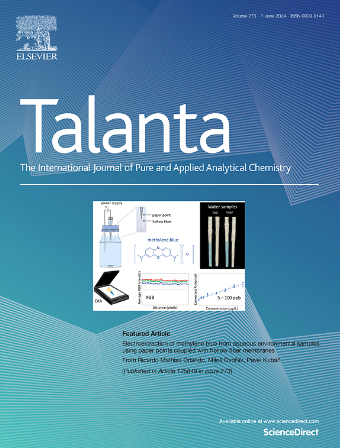CuSeO3@f-CNFs: A superoxide nanozyme for the selective nanomolar determination of the key cardiovascular biomarker, Glutathione
IF 5.6
1区 化学
Q1 CHEMISTRY, ANALYTICAL
引用次数: 0
Abstract
Nanocomposites that mimic the characteristics of enzymes, commonly as nanozymes, can function as an efficient sensing material with high selectivity towards the targeted biological macromolecule. These nanozymes overcome of the challenges that arise when using natural enzymes as sensing material. This study presents a novel nanozyme, Copper Selenite (CuSeO3) nanoparticles mounted on f-CNF, to electrochemically determine a potential cardiovascular biomarker, Glutathione (GSH). The choice of this material is due to the well-known ability of GSH to form a complex with copper. When a Cu ion enters a healthy cell, it quickly forms a complex with GSH, which then moves to another storage molecule: either a metalloprotein or a chelator. CNF was functionalized using acid to generate functionalized-CNF to enhance biocompatibility and boost conductivity. This was done to provide many active sites for effective integration of CuSeO3 in the nanocomposite preparation. The glassy carbon electrode (GCE) surface was enhanced by introducing CuSeO3@f-CNF nanocomposite, resulting in a significant increase in the current response for GSH in comparison to prior research. CuSeO3@f-CNF/GCE sensor has shown excellent sensing properties, like enhanced stability, selectivity, sensitivity, and reproducibility, for detecting and quantifying GSH. The sensor demonstrated an extensive linear detection range from 62.5 nM to 7785.0 μM, signifying one of the most comprehensive ranges documented to date. It attained a remarkable detection limit (LOD) of 17.6 nM. The sensor's performance was further tested by analyzing genuine biological fluid samples. The nanozyme-modified GCE demonstrated exceptional electrocatalytic efficiency for GSH detection, making it extremely appropriate for real-time monitoring applications.

求助全文
约1分钟内获得全文
求助全文
来源期刊

Talanta
化学-分析化学
CiteScore
12.30
自引率
4.90%
发文量
861
审稿时长
29 days
期刊介绍:
Talanta provides a forum for the publication of original research papers, short communications, and critical reviews in all branches of pure and applied analytical chemistry. Papers are evaluated based on established guidelines, including the fundamental nature of the study, scientific novelty, substantial improvement or advantage over existing technology or methods, and demonstrated analytical applicability. Original research papers on fundamental studies, and on novel sensor and instrumentation developments, are encouraged. Novel or improved applications in areas such as clinical and biological chemistry, environmental analysis, geochemistry, materials science and engineering, and analytical platforms for omics development are welcome.
Analytical performance of methods should be determined, including interference and matrix effects, and methods should be validated by comparison with a standard method, or analysis of a certified reference material. Simple spiking recoveries may not be sufficient. The developed method should especially comprise information on selectivity, sensitivity, detection limits, accuracy, and reliability. However, applying official validation or robustness studies to a routine method or technique does not necessarily constitute novelty. Proper statistical treatment of the data should be provided. Relevant literature should be cited, including related publications by the authors, and authors should discuss how their proposed methodology compares with previously reported methods.
 求助内容:
求助内容: 应助结果提醒方式:
应助结果提醒方式:


